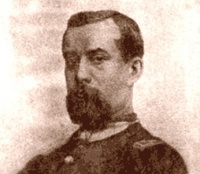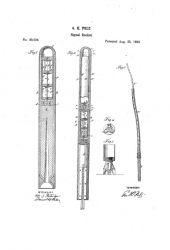George H. Felt
George Henry Felt was a mechanical engineer, architect, and Egyptologist, and one of the Founders of the Theosophical Society.
Personal life and military service
George Henry Felt was born on September 21, 1831 in Boston, Massachusetts as the son of Willard Felt, a wealthy stationer, and Elizabeth Lemon Glover Felt. His father opened a New York branch of his business in the late 1830s. George and his brothers were well educated in New York schools. He married Mary Anne Frain in New York, on September 23, 1854. The family had four sons and four daughters and lived in New York City.
During the Civil War, George Felt volunteered for the Union Army in July, 1861 and was mustered in as a First Lieutenant.[1][2] His unit was the 55th Regiment of Duryea Zouaves, who had a colorful uniform with a red fez and baggy red pantaloons.[3] He served as a signal officer. His mechanical engineering skills led to invention of a rocket flare for military communications, and also a detonator.[4] On August 15, 1863 he was mustered out.[5]
After a career as an engineer and inventor, he died on December 9, 1906 in Milford, Pennsylvania and was buried there.[6]
Career
With his wide-reaching mind, Felt was able to work in many areas of engineering and science - in mechanical, steam, electrical, and civil engineering, and chemistry. He patented numerous inventions, including a mechanism for reefing and furling sails; a rocket flare for military signalling; a vacuum pump; an "elastic breech" mechanism for artillery; a detonator; several galvanic batteries; and a cylinder-based system for storing gas for lighting and power generation.[7]
In 1892 he established the Felt Electrical Light and Power Company to manufacture and sell electrical accumulators and batteries. He continued to work out of a Manhattan office until he was at least 67, but by 1905 had retired to live with his daughter Mary.[8]
Theosophical involvement
Mr. Felt claimed to have discovered how Egyptian priests invoked and commanded the spirits of the elements. He declared he was able to demonstrate this and render them visible. On September 7, 1875, he gave a lecture at Mme. Blavatsky's rooms on the subject "The Lost Canon of Proportion of the Egyptians, Greeks and Romans." About 17 people were present. During the discussion that followed a suggestion was made that a Society be formed to pursue and promote such occult research.
The next day there was another meeting at H.P.B.'s place, The Lamasery, in which Mr. Felt lectured again. During this meeting the idea of a Society was more definitely developed, sixteen people handing in their names for that purpose. A committee of three was appointed to draft a Constitution and Bylaws.
A third lecture was given by Felt on September 13 at the same place, and during this meeting the name of the Theosophical Society was agreed upon.
Mr. Felt was elected as Vice-President of the Society, but failed to keep his promise to demonstrate phenomena. In Col. Olcott's words, "he never showed us so much as the wag of the tail of a vanishing elemental".[9]
According to Theosophical historian Josephine Ransom, "Felt drifted out of The Society. He was in England in 1877 and proposed the formation of a Society for occult research, with himself as President. Nothing came of this proposal".[10]
Boris de Zirkoff wrote:
J. W. Bouton intended publishing a large volume outlining Felt's discoveries, but this venture apparently did not eventuate, and only a most elaborate prospectus of this forthcoming work survives.[11]
According to a New York Times obituary, Felt was a thirty-second degree Freemason.[12]
Publications
Felt wrote one master work to be called The Kaballah of the Ancient Egyptians. It was to be printed by J. W. Bouton, according to a propectus, and later by James R. Osgood, according to the New York newspapers.[13] However the manuscript never reached the stage publication and is now lost.
His family's printing business released two short documents related to George Felt's military inventions:
- Lieut. Geo. Henry Felt's Patent Elastic Breech for Artillery and Heavy Ordnance with Official Reports. New York: Willard Felt Co., 1875.
- Proceedings of a Court of Inquiry Convened by Special Order No. 85, Headquarters Department of Washington, as the request of First Lieut. George H. Felt, 55th N. Y. S. M. and Acting Signal Officer, U. S. A.. New York: Willard Felt & Co. 1865. 68 pages. "An inquiry upon the moral character of Lieut. George H. Felt."
Additional resources
Articles
- James A. Santucci. "George Henry Felt: The Life Unknown". Theosophical History 6.7 (July, 1997), 243-261.
- George Henry Felt at Signal Corps Association website
- The First Leaf of T.S. History by Henry S. Olcott
- Search for George H. Felt’s lost work at Chasing Down Emma blog
- Felt, George Henry in Theosophy World.
- Reassessing the Roots of Theosophy in Pursuit of the Precious Stone by Scott Olsen. First published in Insight (November/December 2018). How Viola de Gruchy and Claude Bragdon came to have some of the Felt papers.
Notes
- ↑ George H Felt in the U.S., Civil War Soldier Records and Profiles, 1861-1865.
- ↑ 1861 New York, Civil War Muster Roll Abstracts, 1861-1900.
- ↑ [http://www.fifthnewyork.com/history.html "Zouave History" in FifthNewYork.com website.
- ↑ George Henry Felt at Signal Corps Association website.
- ↑ U.S., Civil War Soldier Records and Profiles, 1861-1865.
- ↑ Pennsylvania, Veterans Burial Cards, 1777-2012.
- ↑ James Santucci, "George Henry Felt: The Life Unknown" Theosophical History 6.7 (July 1997), 243-261. This source has much more detail about the inventions.
- ↑ New York, State Census, 1905.
- ↑ The First Leaf of T.S. History by Henry S. Olcott
- ↑ Josephine Ransom, A Short History of The Theosophical Society (Adyar, Madras, India: The Theosophical Publishing House, 1938), 111.
- ↑ Boris de Zirkoff, "Felt, George H." H. P. Blavatsky Collected Writings Volume I (Wheaton, Illinois: Theosophical Press, 1966), 463.
- ↑ New York Times December 6, 1906.
- ↑ See New York Herald, September 15, 1872, and

